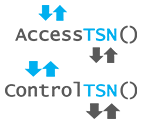 AccessTSN is a public funded research project which was kicked-off in May 2018. Primary goal of the cooperation between research and enterprise partners is to provide an efficient entry into TSN technology and convergent networks especially for small and medium-sized enterprises.
AccessTSN is a public funded research project which was kicked-off in May 2018. Primary goal of the cooperation between research and enterprise partners is to provide an efficient entry into TSN technology and convergent networks especially for small and medium-sized enterprises.
[su_spacer size=”30″]
[su_heading size=”15″ align=”left” margin=”3″]MOTIVATION[/su_heading]
- Time Sensitive Networking (TSN) is the enabling technology for future real-time applications in
– Control and automation
– Transportation and mobility
– Infrastructure and IT - Various partial solutions exist, though no complete application framework is available
- Getting started with the technology is challenging, especially for SME
- The availability of reference designs is crucial for fast adoption in multi-vendor environments
[su_heading size=”15″ align=”left” margin=”3″]CONCEPT OF ACCESS TSN[/su_heading]
- Develop a generic communication framework for end devices in TSN networks
- Provide the functionality of different TSN standards within a vendor-independent application interface
- Use native GNU/Linux networking mechanisms for scheduled traffic
- Rely on industry-proven real-time environments like PREEMPT_RT (all required features are entering mainline kernel)
- Adapt the Linux system configuration and management to upcoming TSN standards
- Integrate open OPC UA functionality
[su_heading size=”15″ align=”left” margin=”3″]WHAT WE DO[/su_heading]
- Requirement engineering from the endpoint perspective for different industries
- Characterizing existing solutions
- Combining existing open source solutions and building unified configuration interfaces
- Development of functionality to support various TSN mechanisms as well as OPC UA
- Setting up test cases and real verification environments
- Reflecting open issues into the current standardization process
[su_heading size=”15″ align=”left” margin=”3″]BENEFITS[/su_heading]
- Support for a broad range of platforms and applications
- Entry point into the technology with minimal effort and without license fees
- Access to a holistic, modular framework combining all needed real-time functionality
- Reduction of maintenance cost and simplification of migration to future technologies


